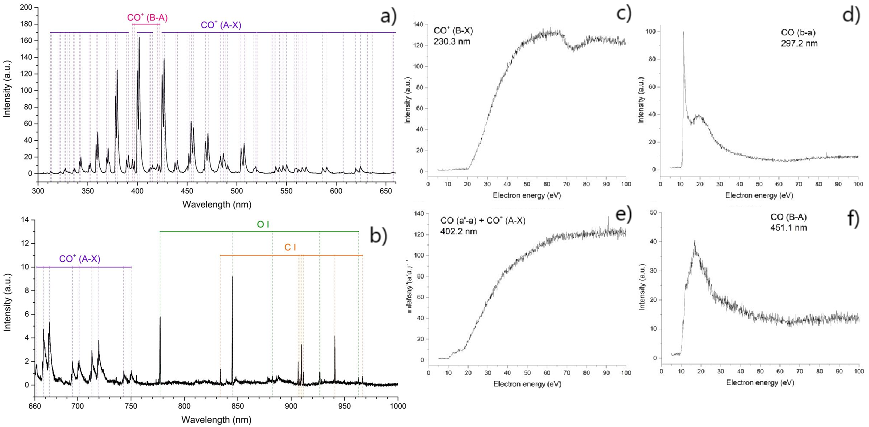Speaker
Description
The electron-induced fluorescence of carbon monoxide (CO) was studied in a crossed electron and molecule beam experiment using optical emission spectroscopy. CO is one of the dominant carbon bearing molecules in the Universe, especially on extra-terrestrial bodies such as comets or centaurs. Many of the previous publications are focused solely on the Comet Tail system of CO$^+$ [1], because of its dominance in higher energy spectra, and the diagnostic of these cometary volatiles is a necessity for solar system formation models [2].
The emission spectrum following electron impact on CO was measured at 5-100 eV within the wavelengths range of 300-1000 nm. The emission bands of CO dominate this spectral region at energies below 20 eV, while the signal from CO$^+$ becomes dominant above this energy. The 50 eV spectrum shows a prominent emission of the Comet Tail system of CO$^+$ (A$^2$Π – X$^2$Σ$^+$), along with a few emission bands of the Baldet–Johnson system of CO$^+$ (B$^2$Σ – A$^2$Π$^+$) and the emission lines of C I and O I. Excitation-emission functions of several emission bands were measured as well, and their threshold energies were estimated. Additionally, a 3D spectral electron energy map was created, consisting of emission spectra measured at energies ranging from 5 to 100 eV with small energy steps. These data provide detailed information about the excitation-emission functions of all individual transitions in the spectra and their threshold energies. The data is suitable as reference data not only for astrophysical research but for any field utilizing emission spectroscopy.

Fig. 1 The emission spectrum of CO measured by CCD camera at 50 eV (a) within 300-660 nm and (b) within 660–1000 nm. Excitation-emission functions: c) CO$^+$ (B$^2$Σ – X$^2$Σ) at 230.3 nm, d) CO (b$^3$Σ$^+$ – a$^3$Π) at 297.2 nm, e) CO (a$^{’3}$Σ$^+$ – a$^3$Π) combined with CO$^+$ (A$^2$Π – X$^2$Σ$^+$) at 402.2 nm, f) CO (B$^1$Σ$^+$ – A$^1$Π) at 451.1 nm.
This work was supported by the Slovak Research and Development Agency under the Contracts no. SK-PL-23-0050, APVV-19-0386 and APVV-23-0522, Slovak grant agency VEGA under project nr. 1/0553/22. Funded by the EU NextGenerationEU through the Recovery and Resilience Plan for Slovakia under the project No. 09I01-03-V04-00047.
References
[1] Holland R F and Maier II W B 1972 The Journal of Chemical Physics. 56 11.
[2] Roth L et al. 2021 Nature Astronomy. 5 1043–1051.


